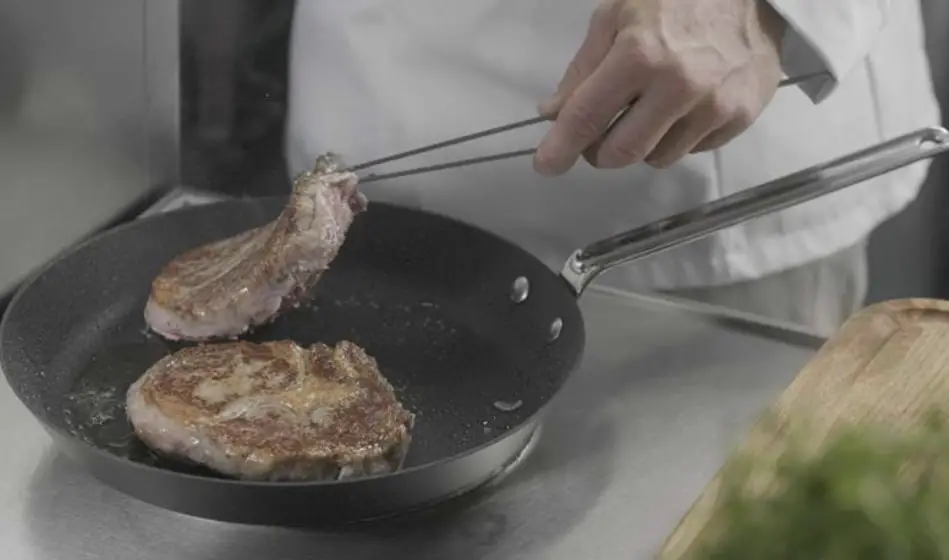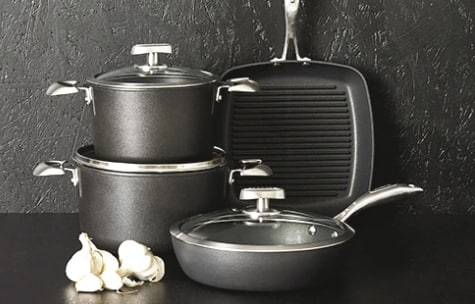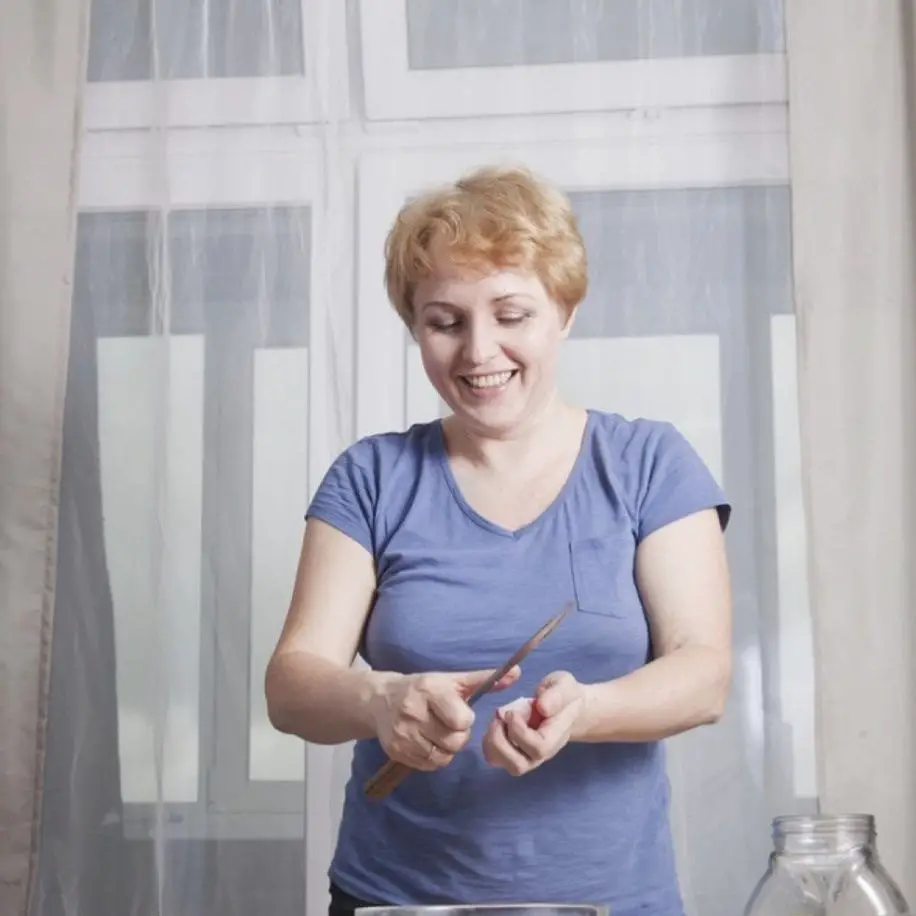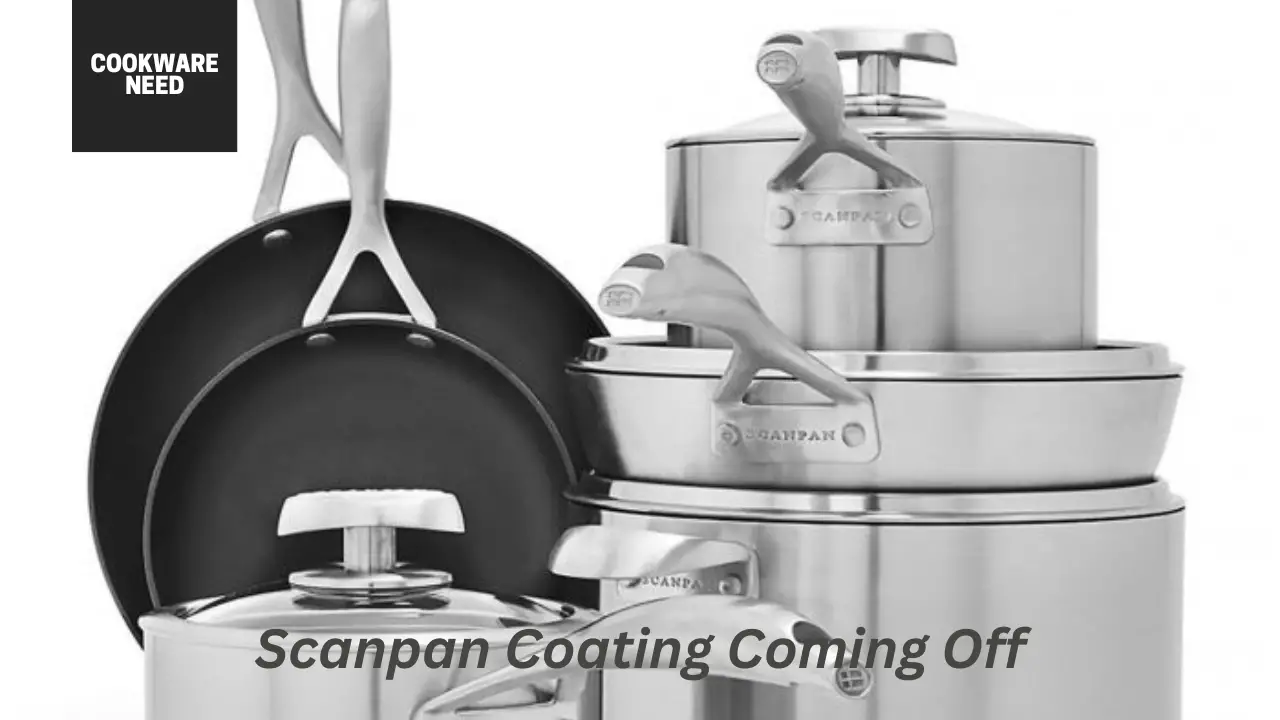The Scanpan cookware is coated with durable non-stick (STRATANIUM or STRATANIUM+) coating. Their products are known for their durability and non-stick properties. However, some users have reported that the Scanpan Coating Coming Off.
It’s important to be aware of the condition of your Scanpan cookware, especially if the coating is starting to come off. If the coating is peeling in large pieces or areas where food will come into direct contact, it’s best to replace the cookware altogether. However, if the coating is only lightly scratched or peeling in areas that will not come into direct contact with food, you may be able to continue using the cookware safely.
Scanpan Coating coming off, so how to restore my Scanpan surface?
First, clean it with hot soapy water and a non-abrasive sponge or cloth. You can try using a gentle cleanser or white vinegar if there are any stubborn stains. Once your cookware is clean, dry it thoroughly with a soft towel.
If your cookware is still not looking its best, you can try seasoning it. Seasoning your cookware will create a protective barrier that will help to keep it from sticking and make cleanup easier.
To season your Scanpan cookware:
- Rub a thin layer of cooking oil onto the surface with a clean cloth.
- Heat the cookware on the stove for about two minutes.
- Allow the cookware to cool completely before wiping away any excess oil.
What is the coating on Scanpan?
Scanpan’s cast aluminum cookware is coated with a material called STRATANIUM or STRATANIUM+. This nonstick coating is PFOA and PFOS-free, meaning it is a healthy option for cooking. The coating can also withstand high temperatures – up to 500°F in an oven – and provides effortless food release. If you’re unfamiliar with STRATANIUM or STRATANIUM+ coating, this article will tell you everything you need to know.

Is SCANPAN coating toxic?
No, Scanpan cookware is made with a material that is non-toxic and safe for cooking. Their cookware is made with a STRATANIUM or STRATANIUM non-stick coating free of PFOA, PFAS, lead, and cadmium.
This means the cookware is safe to use, even at high temperatures, and will not release harmful toxins into your food.
You can feel good about cooking your meals in Scanpan cookware, knowing that the materials used are safe for you and your family.
Is SCANPAN ceramic or Teflon?
No. All Scanpan cookware is made with our patented STRATANIUM or STRATANIUM non-stick coating – instead of ceramic or Teflon. This unique coating contains polytetrafluoroethylene (PTFE), which is used in all major non-stick coatings.
Are SCANPAN made in China?
SCANPAN is a Danish company that makes high-quality cookware. While some of their products are made in China, they also have manufacturing facilities in Denmark and Thailand. They are known for their use of environmentally friendly materials and processes in the production of their cookware.
Can you ruin a Scanpan?
Like any other cookware, it can ruin a SCANPAN if it is not used or cared for properly. Here are a few things that can potentially damage a SCANPAN:
- Using metal utensils: SCANPAN products are made from a material called “squeeze-cast” aluminum, which is designed to be durable and resistant to scratching. However, using metal utensils on the surface can potentially damage the pan. It is best to use utensils made of silicone, nylon, or wood to avoid scratching the surface.
- Using high heat: SCANPAN products are designed to be used on various cooking surfaces, including induction, gas, electric, and ceramic. However, it is important to avoid high heat, as this can damage the pan and cause it to warp or become misshapen.
- Dishwasher use: While SCANPAN products are dishwasher safe, they should be washed by hand to preserve the finish and maintain their optimal performance. Dishwasher detergents can be abrasive and may cause the pan to become discolored or damaged over time.
- Storing heavy objects on the pan: It is important to avoid stacking heavy objects on top of the pan, as this can cause the pan to become misshapen or damaged.
By following these tips, you can help ensure that your SCANPAN cookware stays in good condition for a long time.

How to repair any non-stick cookware?
If your non-stick cookware has become damaged or is no longer performing as well as it used to, there are a few steps you can take to try to repair it:
- Clean the pan thoroughly: Remove any food debris or burnt-on residue from the pan’s surface. This will help you better understand the damage’s extent and allow you to assess whether the pan can be repaired or needs to be replaced.
- Sand down any rough or damaged areas: If the pan’s surface is rough or has become scratched or damaged, you can try sanding it down using fine-grit sandpaper. Be sure to sand gently and evenly to avoid causing further damage to the pan.
- Apply a non-stick repair spray: Several products are specifically designed to repair and restore non-stick surfaces. These sprays can help fill in scratches and smooth out rough spots, improving the pan’s performance.
- Season the pan: If the non-stick coating has become damaged or worn, you may be able to restore it by seasoning the pan. To do this, lightly coat the pan’s surface with a thin layer of oil, then heat the pan over medium heat until the oil starts to smoke. Remove the pan from the heat and allow it to cool, then wipe off any excess oil. Repeat this process a few times to help rebuild the non-stick coating.
Remember that these techniques may not work for non-stick cookware; in some cases, it may be necessary to replace the pan. If you cannot repair the pan or are unsure how to proceed, it is always a good idea to consult the manufacturer or a professional for advice.
Are peeling non-stick pans safe?
Peeling non-stick pans can be dangerous because the non-stick coating is often made with polytetrafluoroethylene (PTFE), which can release harmful fumes when heated to high temperatures. These fumes can be inhaled and can cause respiratory problems, including a condition called polymer fume fever.
It is generally safe to use non-stick pans as long as you follow the manufacturer’s instructions and use them properly. This includes using the pan on low to medium heat, not heating it to high temperatures, or leaving it empty on a hot burner. It is also important to avoid using sharp utensils or abrasive scrubbers, which can damage the non-stick coating and increase the risk of peeling.
If you do notice that the non-stick coating on your pan is peeling or flaking, it is important to stop using the pan and replace it. Using a pan with a damaged non-stick coating can increase the risk of the PTFE being released into the air, harming your health.
Do you need oil in SCANPAN?
SCANPAN cookware is designed to be non-stick, which means that you generally do not need to use a lot of oil or other types of fat when cooking with it. The non-stick coating on SCANPAN pans helps to prevent food from sticking to the surface, so you can usually cook with just a small amount of oil or no oil.
However, it is still a good idea to use oil or fat when cooking with SCANPAN cookware, as it can help add flavor to your food and prevent it from drying out. You can use a small amount of oil, butter, or fat to coat the pan’s surface before cooking. This will help prevent the food from sticking and add flavor to your dishes.
Using the right type of oil or fat when cooking with SCANPAN cookware is important. Some oils and fats have a low smoke point, which can burn or break down at high temperatures. This can create smoke and cause the non-stick coating on your pan to become damaged. To avoid this, it is a good idea to use oils and fats with a high smoke point, such as canola oil, vegetable oil, or grapeseed oil.
Can you use olive oil on SCANPAN?
Yes, you can use olive oil on SCANPAN cookware. Olive oil is a common cooking oil used in various dishes and can be used in SCANPAN cookware just like any other oil.
However, it is worth noting that olive oil has a relatively low smoke point compared to some other types of cooking oils. The smoke point of an oil is the temperature at which it begins to break down and produce smoke. Oils with a low smoke point are more prone to burning and can create smoke when heated to high temperatures.
Olive oil has a smoke point of around 350-410°F, depending on the type of olive oil and its quality. This means that it is generally not suitable for high-heat cooking methods like frying or grilling. Instead, it is best used for low to medium-heat cooking, such as sautéing or roasting.
If you use olive oil on SCANPAN cookware, it is a good idea to use it sparingly and avoid heating the pan to high temperatures. This will help prevent the oil from burning and creating smoke, damaging the non-stick coating on your pan. Also here you can look and choose the right types of oil for ceramic pan (if you have).
Can you overheat a Scanpan?
It’s not recommended to overheat a Scanpan. All cookware, including SCANPAN, can be damaged if heated to excessively high temperatures.
The non-stick coating on SCANPAN cookware is designed to withstand high temperatures, but it can still be damaged if it is heated to temperatures that are too high for an extended period.
For example, if you leave an empty SCANPAN pan on a hot burner or in an oven set to a high temperature, the non-stick coating can become damaged and may start to peel or flake off.
To avoid overheating your SCANPAN cookware, it is important to follow the manufacturer’s instructions and use the pan on low to medium heat whenever possible.
Using a thermometer to monitor the pan’s temperature if you are cooking at high heat is also a good idea. This can help you to avoid overheating the pan and damaging the non-stick coating.
Can Scanpan go in the dishwasher?
Yes, Scanpan goes in the dishwasher. The company’s website indicates that most of its cookware, including its frying pans, sauté pans, and roasting pans is safe to clean in the dishwasher.
However, it is always a good idea to check the care instructions with your SCANPAN cookware to ensure that it is safe to clean in the dishwasher. Some SCANPAN cookware items may have specific care instructions or be unsafe to clean in the dishwasher, depending on the type of non-stick coating used.
To ensure the longevity of your SCANPAN cookware, it is generally a good idea to hand wash it with warm, soapy water and a soft sponge or brush. This will help to preserve the non-stick coating and keep your cookware in good condition.
Does SCANPAN honor its warranty?
SCANPAN is a well-known and reputable cookware manufacturer, and it is likely that the company will honor its warranties as long as they are valid. Suppose you have a SCANPAN product covered under warranty and are experiencing a problem with it. In that case, you should contact the company directly to learn more about your options for repairing or replacing the product.
How long should a Scanpan last?
It isn’t easy to accurately estimate how long a SCANPAN cookware product will last, as it can depend on various factors, including the type of product, how it is used, and how it is cared for.
Conclusion
I hope our detailed article and tips will help you in using Scanpan Сookware. Thanks for reading this page.

I am Linda. A housewife and a writer, and also the founder of this site. I love cooking and collecting cookware sets. I’ve been blogging since 2020, and in this blog, you can find cookware-related problems and solutions, cookware reviews, safe cookware sets, and more.
I have put a lot of effort into gathering here the experience and knowledge that I have, and I want to help every reader.

